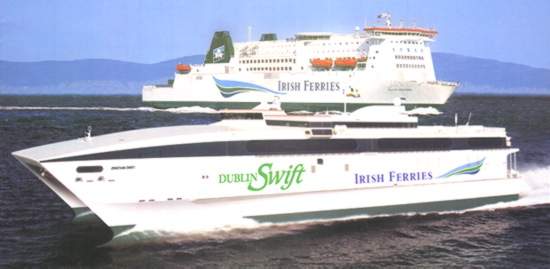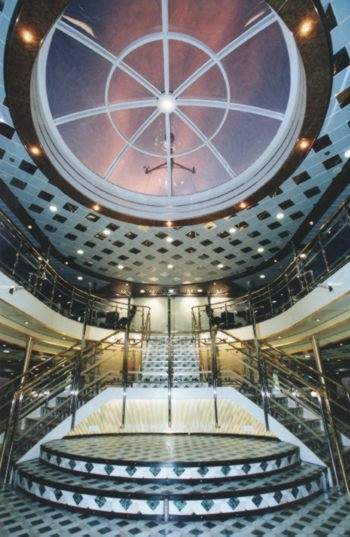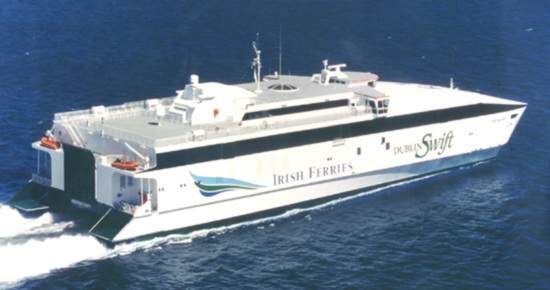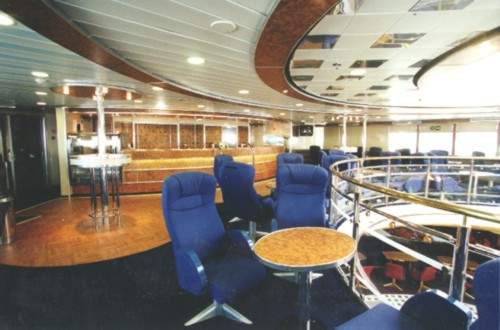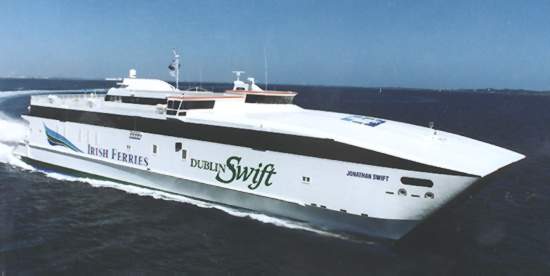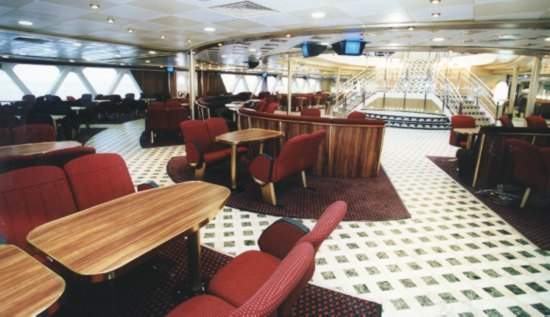Irish Ferries entered the world of high-speed shipping when the company took delivery in May 1999 of its first fast ferry, Jonathan Swift. Built by Australian aluminium fast ferry builder, Austal, in its Fremantle yard, the vessel is the eleventh Austal Auto Express catamaran and the third 86m-long version to be commissioned.
Jonathan Swift entered service on the Dublin to Holyhead route in June 1999 alongside the cruise ferry Isle of Inishmore, reducing the crossing time to one hour and 50 minutes, and tripling the frequency of sailings to six a day in each direction. The vessel flies the Irish flag and has Germanischer Lloyd classification.
DESIGN
Jonathan Swift features a semi-swath hull form which, together with the Austal Ocean Leveller ride control system, T-foils forward and variable interceptors aft ensures optimum passenger comfort and seakeeping qualities. She has a capacity for 800 passengers and carries a crew of 30. Nine main and six mezzanine deck lanes are arranged on the vehicle deck to accommodate either 200 cars or a combination of 125 cars and ten buses. The catamaran can also carry commercial vehicles in its centre lanes where the overhead clear height is 4.4m. Jonathan Swift is the third Auto Express to have a bow door, and the operators have a drive-through configuration on the vehicle deck, optimising driver convenience and cutting port turnaround time. Furthermore, the vessel uses the existing loading ramps and terminal facilities in Dublin and Holyhead.
Described by its builder as ‘the world’s first 40 knot Irish pub’, the vessel’s passenger areas have a distinct Irish flavour, echoed in the names given to the public areas. These include the trinity lounge on the upper deck, the poolbeg restaurant forward on the main deck and the temple bar aft on the main deck. Appropriately, children are catered for in the Lilliput area.
Passengers can enjoy live entertainment during the crossing from seating arranged in a semi-circular pattern around a central atrium and stage. Television monitors broadcast the entertainment throughout the ship, while a large cinema screen with theatre-style seating is positioned aft of the atrium and displays the entertainment to those not able to view the stage directly. There is also a 126m² Swift shopping area, situated aft on the main deck.
PROPULSION
Jonathan Swift is powered by four 7,200kW Caterpillar 3618 diesel engines and is the first Austal Auto Express vessel to use prime movers from the US engine builder. According to Caterpillar, these latest generation engines incorporate more strength, higher ratings and better specific fuel consumption of 200g/kw/h. Each engine powers a Kamewa 112 SII waterjet via a Reintjes VLJ6831 gearbox. The vessel has a service speed of 40 knots, with a 42 knot maximum speed. A Litton Marine integrated ship’s instrument system enables the monitoring of the engines and machinery space from the engineer’s station.
AUTOMATION AND CONTROL
The Austal-developed Marine Link system undertakes the control and monitoring of power management, air conditioning and ventilation and emergency shutdown systems. The captain’s and first officer’s chairs feature Kelvin Hughes Ergopod systems on the armrests, which permit total control of the radar and chart displays with a trackerball from the seated position. The bridge features a 360° view, with docking achieved either centrally or from the wing stations.
Life-saving requirements are met by four liferaft systems with Australian-supplied Marine Evacuation System stations, which can be activated either locally or from the bridge. These are complemented by six 100-person liferafts that are situated on the bridge deck superstructure.

